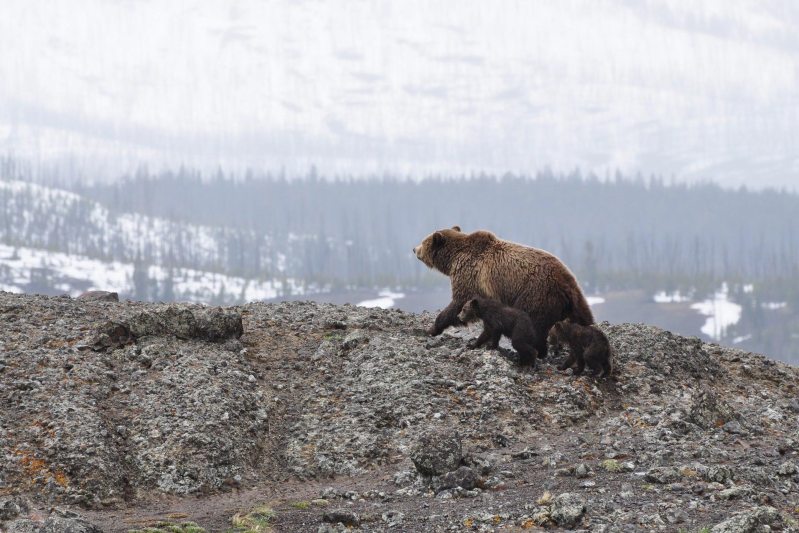
The likelihood of a bear attack is near zero for most of us. Still, avid hikers and outdoorsmen understand the importance of bear spray in the backcountry. But carrying it is of no use if you don’t know how to use it. Here’s the lowdown on how to use bear spray properly if you’re ever on the receiving end of an attack.
What is bear spray?

In simplest terms, bear spray canisters work like personal pepper spray on steroids. They rely on the same active ingredient: Capsaicin. It’s what makes hot peppers hot. Technically, it’s a chemical irritant for mammals that burns when it comes in contact with any tissue, especially the mouth, eyes, and mucus membranes. The most potent bear sprays, like those from Counter Assault, contain 2% capsaicin, which is the strongest allowed by law. It’s your best non-lethal defense in the backcountry.
Bear spray how-tos

Learn how to carry bear spray, how to practice using it (you don’t want to “practice” during the real deal), how to use bear spray properly, what to do after you’ve used it on a bear, and more tips.
Carrying bear spray
While bear attacks are rare, they can happen very, very quickly. Though a 600-pound male grizzly looks slow and lumbering, they’re capable of charging at up to 35 miles per hour (For proof, watch this video of a grizzly keeping pace with a driver in Alaska). If one has you in its sights, you’ll need to act quickly. That means keeping your bear spray accessible. Don’t stash it in your backpack. Keep it in a pouch on your belt or secured to the shoulder straps of your backpack within easy reach. If you’re a frequent trail runner, consider a neoprene bear spray holster belt like those from Counter Assault or Scat.
Practice makes perfect
The first time you use bear spray shouldn’t be during a bear encounter or attack. Practice beforehand. You can find two-in-one kits that include a can of bear spray and an inert trainer can. The latter works like the real deal, minus the active ingredients. So, you can practice in your yard without the risk of a face full of burning pepper spray.
How to use bear spray
It seems obvious, but it bears repeating: The best way to survive a bear attack is to avoid encounters in the first place. Unfortunately, that isn’t always up to you to decide. If you come upon a bear in the distance and it hasn’t noticed you, give it a wide berth. Go back the way you came or navigate far around the bear’s location, trying to remain upwind as best you can. If the bear is close, do the same, but back away slowly to keep your eyes on it.
If the bear notices you, continue backing away, wave your arms, and signal to the bear you’re not trying to sneak up on it. Now’s the time to take note of the wind direction. If you need to use your bear spray, you don’t want it blasting you in the face. It’s also the time to get your bear spray in hand and — most importantly — ensure the plastic (usually white) safety tab is off. Continue backing away slowly.
If the bear charges, you’ll need to fight the instinct to run. You won’t outrun any bear — grizzly, black, or polar — on foot. Stand your ground. Wait until the bear is within 10-20 yards, aim for the chin, then press the thumb trigger on your bear spray, emptying the entire can into the bear’s face as best as you can. Many bear sprays deliver strong, consistent, 40-foot spray for up to 8 seconds from a can that’s about the size of a Febreze bottle.
After a bear encounter
Once blasted in the face with a full can of bear spray, most bears are likely to retreat. Don’t stick around, as they may return to the scene of the encounter. This is especially true if they’re predatory, meaning they’re likely to stalk you despite properly deployed bear spray. That could also be true if you didn’t get enough spray into the bear’s face to deter them fully. It’s impossible to know, so the best course of action after an encounter is to flee the scene calmly but quickly. If it happened in a national park or forest, let the nearest ranger station know about the event.
Other things to know about bear spray
The active ingredient in bear spray naturally degrades over time. Most sprays, including those from Sabre and Counter Assault, have a shelf life of four years. The expiration date is printed directly on the canister. Always discard and replace old canisters immediately before heading into the backcountry. Also, be sure to store them away from extreme temperatures, such as inside a hot car or in your garage, where they may freeze. This not only causes them to degrade faster but can force the cans to burst.
You may consider taking a class on bear spray, where they’ll cover all the important things to know, such as bear awareness, types of bear spray, proper storage and handling, deployment techniques, and safety precautions REI hosts an excellent course on staying safe in bear country. Some local wildlife organizations or park services may offer in-person bear spray workshops. These workshops often provide hands-on practice using inert training spray (spray with no active capsicum) in a safe environment. Look for organizations in your area that offer wildlife safety or bear awareness programs.



